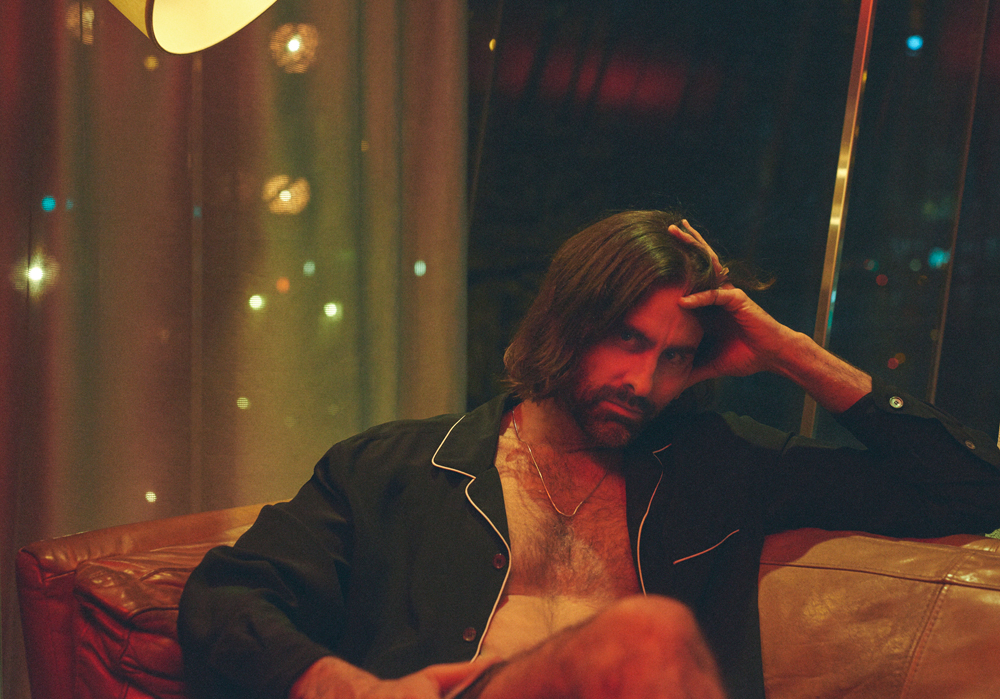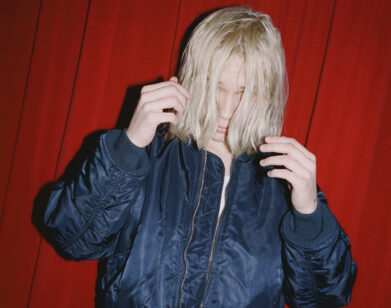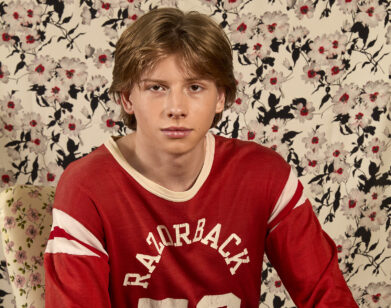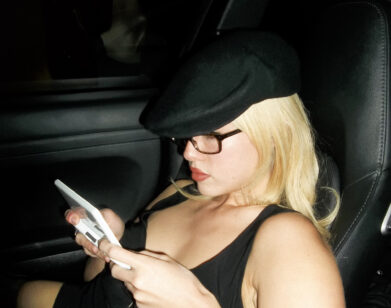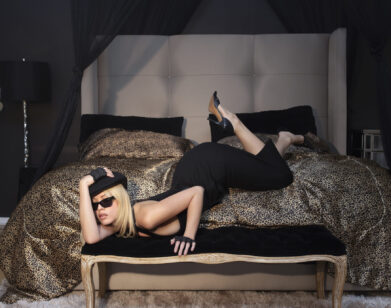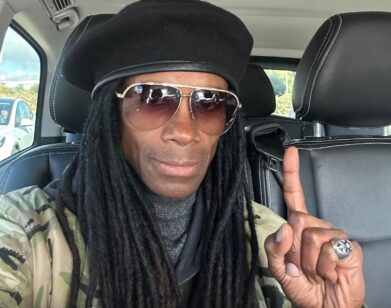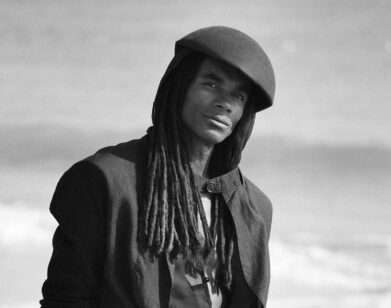Andrew Wyatt’s System of Sound
ANDREW WYATT IN NEW YORK, MARCH 2016. PHOTOS: SEBASTIAN SABAL-BRUCE. STYLING: NINA STERGHIOU/BRIDGE ARTISTS. GROOMING: ALLIE SMITH USING MARIO BADESCU AT SARA LAIRD & GOOD COMPANY. SPECIAL THANKS: THE STANDARD, EAST VILLAGE.
On Valentine’s Day this year, the VW Dome at MoMA PS1 was dimly illuminated by rotating, planetarium-like lighting during a six-hour performance by musician, singer, and sound artist Andrew Wyatt. Largely known for his work in the trio Miike Snow, Wyatt stood on stage, mixing and procuring obscure sounds, nonstop, with different vocalists (including Charli XCX and Empress Of) joining him every hour, for what resulted in an immersive, ethereal, and meditative experience entitled “Valium Valentine.” Less than a month later, Miike Snow released its third album iii and embarked on a North American tour. Tonight, Wyatt, alongside band members Christian Karlsson and Pontus Winnberg, will play at San Francisco’s The Independent, before performing during both weekends of Coachella.
In addition to Miike Snow, the New York City native is also part of the Swedish collective Ingrid (which comprises Lykke Li, Peter Morén, Björn Yttling, John Eriksson, and more), and produces and writes songs for artists including Beck, Carl Barat, Mark Ronson, Flume, and Bruno Mars (such as the Grammy Award-nominated track “Grenade”). Before Miike Snow was founded in 2007, Wyatt played in The A.M. and Black Beetle, and in 2013, between Miike Snow albums, he released a solo LP, Descender, featuring the 75-piece Prague Philharmonic Orchestra.
Earlier this month, Wyatt connected with his longtime friend and supporter, the art dealer and curator Jeffrey Deitch, over the phone. The two talked about the evolution of New York, hanging out in Miami, and the role of social media in both visual art and music.
ANDREW WYATT: Hello, Jeffrey, it’s been a while. Long time no talk.
JEFFREY DEITCH: So you know, I was at the [MoMA] PS1 performance. I didn’t stay the whole six hours, I stayed about an hour, but that was a great party. I didn’t want to disturb you.
WYATT: Well, thank you. What a great surprise. That was definitely something that I had to cram into a very busy schedule. My album just came out with Miike Snow and working with people like Charli and Empress Of, you have to work around everybody’s schedule. We didn’t have quite enough time to rehearse, but, as usual, the show must go on.
DEITCH: It came off very well, and in that context, people expect something a little more participatory. You’re not sitting in seats for a concert.
WYATT: That’s true. They sent me the tapes yesterday of the performance and when I watched it, it really doesn’t capture what it’s like to be there. In the video, you see mistakes and people coming in early or late. In person, those things melt away because it’s more about an energy.
DEITCH: Being inside the globe, inside the sphere, it makes the audience feel that they’re inside the performance; they’re not on the other side watching a performer on stage. So even if you’re not making the music, you feel that you’re participating in it. It wasn’t like a conventional musical performance. It was much looser, more open, and closer to actual life experience. The audience can talk, they can go out and have a smoke, and they can come back in and concentrate. The music lent itself very well to that format.
WYATT: We thought about that because the venue is such an important determining factor; the parameters that you’re playing within are going to affect the decisions that you make. For example, there’s that wonderful surround sound system in there, so I would write parts that could be panned from one speaker to the next, so that they would surround the listeners. From that you also have the way people are listening—they can get behind the stage, they can get in front of the stage—and those affect your performance decisions as well.
DEITCH: The sound becomes sculptural.
WYATT: Exactly, and like you said, participatory. It’s where the aesthetic of the visual really influences the music, and vice versa. That leads me to something I heard you say in an interview recently about “aesthetic energy,” which is a very interesting phrase that I hadn’t heard before.
DEITCH: One of my aesthetic interests is blurring the borders between art and music. I’m very interested in work where you can’t describe it as just visual art, or just music, or just performance, where it draws on all of these media to create a very immersive, contemporary experience.
WYATT: Charles Ives [an American modernist composer] might have been one of the first people who started blurring that boundary in the beginning of the 20th century.
DEITCH: Yeah, he was a pioneer. He talked about one of his big inspirations—when he was at a parade in Connecticut when he was young. There were two marching bands, one lost the other, and he heard the music of the two marching bands merging. Reading about that was such an inspiration for me, because it was very, very modern.
WYATT: Me too, actually. I remember that story well. When I was coming up, so to speak, in New York, in the early 2000s, there was a quirky insider-outsider energy that was striking, which people later put a label on. In the music scene it’s called New Weird America, and the Deitch Projects were sort of the visual embodiment of that. I remember going to [the Terry Richardson exhibition] “Terryworld,” for example, and also, the Paul McCarthy exhibit [“The Garden”]. Even if Paul McCarthy had been around a long time, it was that moment that made him a superstar all over again for a new generation. His work took on this relevance in new context.
DEITCH: We’re getting back the Wooster Street space in August and programming it again. In fact, we’re going to revive KiKi [Smith]’s seminal show from 1991 in the fall. The program’s going to be more historic, more thematic… This isn’t a question, but I want to go back to that performance we collaborated on, that we presented at the MoCA Beach Party [in 2012]. That was an outstanding performance, with you, Pontus Winnberg, Björn [Yttling], and Lykke Li. When I present works by artists, musicians, performers, my goal is to provide a platform and concept that inspires the creation of something that didn’t exist before, so it was a thrill to see what came out of that.
WYATT: It was a thrill for us too, because that was not a proper band and we finished an album. Because of that performance, we realized that we needed to continue and we’ve been recording for the last couple of years, and the album’s going to come out this year. So thanks for that.
When you started doing creative projects as a gallerist, you used to put up the money for production costs for artists. Like, I read an article about how you almost bankrupted yourself providing Jeff Koons with the funds he needed because you believed in him. I think that’s often an important thing that people miss out on. They think these cultural movements just happen, but you need to have someone who believes in your work enough to push it forward. There has to be certain key people, like yourself, that come in and open the space up, and sometimes that space can only be opened up with money.
I don’t know if it works the same way in the art world, but in music, people will just put up a video on YouTube. Justin Bieber, take him as a perfect example: Some young boy puts up a bunch of cover songs of himself singing on YouTube, and in this completely egalitarian way becomes a superstar. Do you think that has any correlation in the art world?
DEITCH: In art, there are numerous Instagram and YouTube stars now, but unlike how music can go directly to the audience, art has this very complex structure with layers of endorsement. Art critics, curators, collectors, galleries, auction houses, and this whole structure of what people call the “art world” has an immense influence and it’s very hard for people to crack it if they don’t play the game. That’s the source of frustration for people doing very interesting art, who don’t know how or aren’t interested in playing this game of cultivating tastemakers and building the consensus. So far, I’m not aware of someone with a phenomenal Instagram who, within a couple of years, is selling at auction for big money. I think the power of these new structures is going to eventually penetrate and it will be a different aesthetic hierarchy, but it’s not quite there yet.
WYATT: The other fascinating thing about the post-modernist era is that so many things are nuanced by context. What’s going to happen when you can endlessly decontextualize things by breaking down barriers between media, so that music and visual art is a fluid thing that can be accessed at any point?
DEITCH: This fluidity is one of the biggest things going on in art today all around the world.
WYATT: I went to see “Surround Audience” at The New Museum, the triennial, and there were two themes I saw coming up again and again: a dystopian apocalyptic scene and social media. [laughs] That’s an interesting combination.
DEITCH: Yes, I saw it and agree that those are both central. The most interesting work abstracts it all. It may take those two strains and transform them into a three-by-two-foot painting. The best that art can do is take very complex forces and distill it into something very sharp and simplified.
WYATT: One of the first times we hung out was at the de la Cruz Collection in Miami. I figured, “I’m here with two very influential people in the art world, so let’s ask the simplest question: ‘What makes you think that a piece of art is relevant or important?'” You had a great answer, which was that you have an instinctual response in the first 20 seconds you spend with a piece and the first 20 minutes that you’re walking around the gallery. Then you walk away from it and when you’re eating your breakfast, does it come back to you? If you read the newspaper, does it make you think of a piece of art? And that’s how you start to distill whether something has relevance or not.
So that was an interesting day, and I guess that’s what I try to do with music, that’s why technology always plays a big role in making the music. You look at Skrillex, Sonny [John Moore], and he arrived in a very simple way—just him and his laptop—and now Justin Bieber and him have come together to do music. Sometimes the feedback that you get from society will reinforce what the critic can look back on and see relevance in; the world at large is telling you it’s relevant. It’s like studying it the same way you study why a hurricane happened—what kind of forces were in collusion to create a hurricane? It becomes this reflexive thing about the phenomenon of music, but the same fundamental principles are playing a role. It’s the same principle of being able to distill a lot of complex forces in society, in nature, and in the world, into a pop song four minutes long, or a five-by-four painting.
DEITCH: Let me ask you a question, and this is a big one. How does your music reflect our contemporary situation, and how is your music different from what you or a musician you admire might have done 20 years ago?
WYATT: Well, the first Miike Snow record was not anything we did intentionally, because the thing about music, and pretty much all art, is that you don’t have any time to think. If you think about what color ink to use to write down your inspiration, then your vision will be gone. You have to act on your instinct. So that’s basically what we always do when we’re in the studio—we see what kind of instinctual reaction we’re having to whatever instrument someone picks up by accident. There’s an aleatory aspect to it, but then it gets shaped by instinct. I think Miike Snow accidentally mixed up the first impulses of EDM music, plus pop music, plus indie, like the Velvet Underground lineage-type music. I think the first Miike Snow record was one of the first records where you saw this tearing down of the wall between independent music, electronic dance music, and pure pop, top 40 pop music. It was a mixing of disparate elements, which is always what art is.
A very exciting thing about music is that you’re pushing a button for people that sometimes they didn’t even know was there. I think you need music for culture to emerge, because music has this way of displacing rational thought and contacting other levels of instinct in people. You can go into a club and come out with a completely different mindset. Maybe it’s a nuanced thing, but over time you can actually change your world view by listening to a lot of music. It’s clear that people do that, but it’s also not a very easy thing to do and it’s not something that you can just decide that you’re going to do. You have to sort of wake up in a dream, or wake up from a dream, and ride that fine line between having a sense of direction and letting the wave take you. I think that’s the different element that we put together in the first Miike Snow record.
DEITCH: What I find so interesting, both in music and visual art, is so much of the powerful work today comes from the juxtapositions of directions that formally were thought to be incompatible. Something that’s shaped my whole music consciousness is that I’m very much a product of the early- and mid-70s in New York, where one night I would be at The Kitchen, hearing a Steve Reich concert, and the next night I would be at CBGB listening to the Ramones and Talking Heads, and then, on the weekends, I would go to one of the disco clubs. These three different genres, all thriving in downtown New York and seen to be incompatible, had been fused in a fascinating way, and that’s a lot of the foundation of the best contemporary music.
WYATT: I completely agree. It made me think that the wonderful thing about our neighborhood in New York at that time was that it was mainly abandoned. You had the heart of global finance a quarter mile from where artists were living in cold squats on Canal Street. Manhattan, at that point, needed that gutted out center, where anybody could afford to live, and to have that melting pot. I don’t think we’ll see that proximity again in our lifetime, but I was thinking, as you spoke, that the new melting pot is the internet.
DEITCH: [laughs] There are still some pretty raw and abandoned places in New York City, it’s just not quite as concentrated—and there is some approximation of this in Los Angeles now, but it’s quite different because you don’t walk out on the street and see the great geniuses of music and art and poetry. You have to get in the car and find them at some official reading or exhibition opening. It’s not like its replaced New York, but the energy of L.A. has created a wider creative situation.
WYATT: There was always a vibrant scene in L.A., but I’ve definitely noticed that a lot of my friends in New York are choosing to be out here. It used to be a clearer choice for people, especially in music, to move to New York, but now I think a lot of people are making the choice to come to L.A. [pauses] Is there anything else you want to ask, Jeffrey?
DEITCH: No, I think we covered it pretty well. I look forward to seeing you soon in person.
WYATT: You too, Jeffrey, I’ll see you soon.
FOR MORE ON ANDREW WYATT, FOLLOW HIM ON TWITTER.

